
| Version | Summary | Created by | Modification | Content Size | Created at | Operation |
|---|---|---|---|---|---|---|
| 1 | Brankica Babec | + 7057 word(s) | 7057 | 2021-11-25 06:53:04 | | | |
| 2 | Camila Xu | -165 word(s) | 6892 | 2022-01-11 01:49:35 | | | | |
| 3 | Camila Xu | -165 word(s) | 6892 | 2022-01-11 01:51:08 | | |
Video Upload Options
The ongoing climate change, coupled with the transformations of cultivation practices and land use in sole crop production, may cause a significant decline in sunflower yield stability. Considering that the sunflower is the third oilseed in the world oilseed market, with 45 million tons of grain per year, and that it takes the fourth position in the vegetable oil market, the implementation of sustainable growing technology in sunflower production is a necessity. Considering the above, the goal of the research was to analyze and recommend sustainable sunflower production technology in intercropping systems. A four-year trial was conducted in Serbia’s agroecological conditions (45∘34′23.2'' N 19∘86′18.9'' E) using a split-plot design. Two oil-type hybrids and one confectionary-type hybrid were intercropped with common vetch, red clover, and alfalfa. Common vetch × sunflower intercropping resulted in the decrease in almost all sunflower traits. Moreover, sunflower × alfalfa intercropping proved to be the most appropriate. The yield of NS Gricko and Rimi PR were statistically on the same level with sole cropping, while alfalfa biomass had better results after alfalfa was intercropped with NS Gricko, as compared to sole cropping. In view of the prevailing belief that yields are more stable in intercropping than in sole cropping, further research is needed in this respect, in addition to further research of the time and method of sowing.
1. Introduction
- Analyse and recommend sustainable production technology of sunflowers in intercropping systems. The research considered sunflowers as the main cash crop, and investigated different legumes as complementary crops;
- Define the most suitable legumes for intercropping with sunflowers. The aim is to determine how legumes affect sunflower production, qualitative, physiological and morphological traits:
- Analyse how this system affects perenniallegumes as crops that remain for exploration in the second year after the sunflower harvest (in the first year).
2. Experimental Design
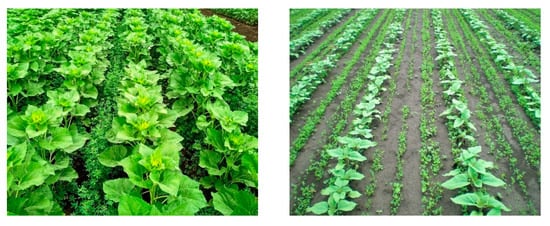
Figure 1. Spatial arrangement of the sunflower legume intercropping (six rows of legumes between two sunflower rows).
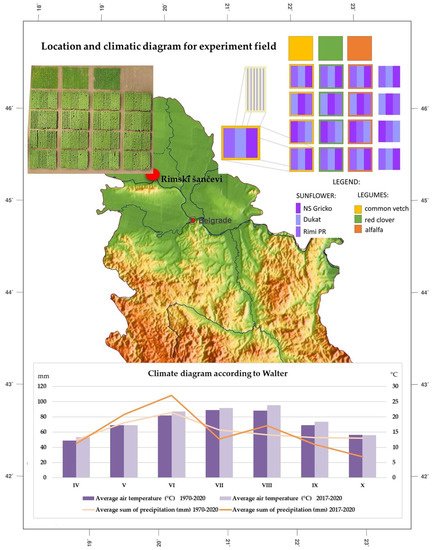
Figure 2. Location of the trial and climatic conditions for the study period with long-term averages.
3. Field Site Description
3.1. Location and Weather Conditions
3.2. Soil Sampling and Characteristics

4. Plant Biometric Assessment
4.1. Yield and Yield-Related Traits in Sunflower
4.2. Biomass and Biomass-Related Traits in Legumes
4.3. Land Equivalent Ratio (LER)

5. Statistical Analyses
6. Yield and Yield-Related Traits in Sunflower
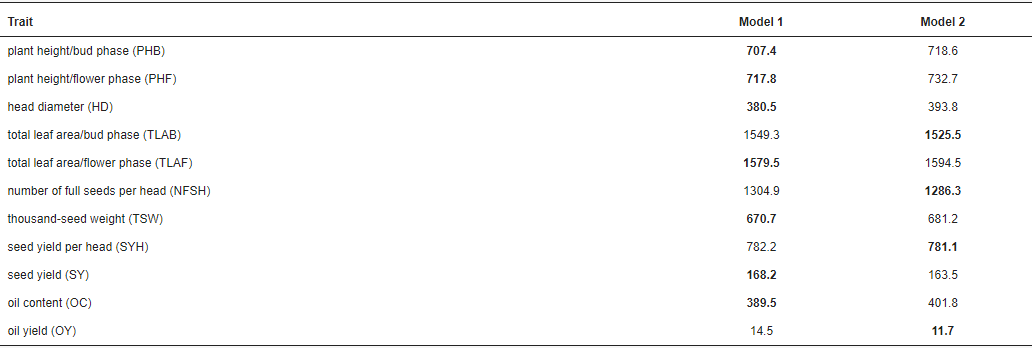

PHB—Plant height/bud phase, PHF—Plant heigh/flower phase, HD—Head diameter, TLAB—Total leaf area/bud phase, TLAF—Total leaf area/flower phase, NFSH—Number of full seeds per head, TSW—Thousand seed weight, SYH—Seed yield per head, SY—Seed yield, OC—Oil content, OY—Oil yield; * and ** indicated significant differences were found at p = 0.05 and 0.001, respectively; ns—not significant; values from the models selected on the basis of Table 2.

HD—Head diameter, OC—Oil content, PHB—Plant height/bud phase, PHF—Plant heigh/flower phase, SY—Seed yield, TLAF—Total leaf area/flower phase, TSW—Thousand seed weight, NFSH—Number of full seeds per head, OY—Oil yield, SYH—Seed yield per head, TLAB—Total leaf area/bud phase; capital letters in superscript denote differences between hybrids; small letters in superscript denote differences between legumes.

Figure 3. Heat map of sunflower trait correlations (average of all three hybrids); correlation thresholds: 0.05 = 0.576, 0.001 = 0.708; (a) sunflower × common vetch intercrop; (b) sunflower × red clover intercrop; (c) sunflower × alfalfa intercrop; (d) sunflower sole cropping; the magnitude of the correlation is denoted with a colour, whereby red indicates a positive correlation and yellow denotes a negative correlation. The stronger the correlation, the darker is the colour; HD-head diameter; OC-oil content; PHB-plant height in bud phase; PHF-plant height in flowering; SY-seed yield; TLAF-total leaf area per plant in flowering; TSW-thousand seed weight; NFSH-number of full seeds per head; OY-oil yield; SYH-seed yield per head; TLAB-total leaf area per plant in the bud phase.
7. Biomass and Biomass-Related Traits in Legumes


* and ** indicated significant differences were found at p = 0.05 and 0.001, respectively; ns—not significant; values from the models selected on the basis of Table 5.

Letters in superscript denote differences between different intercrops within each legume; significance level 95%.
8. Indicators of Intercropping Competition and Efficiency
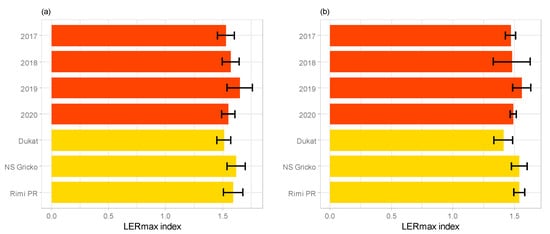
Figure 4. Adjusted land equivalent ratio (LERmax); (a) sunflower × red clover; (b) sunflower × alfalfa intercropping.
9. Discussion
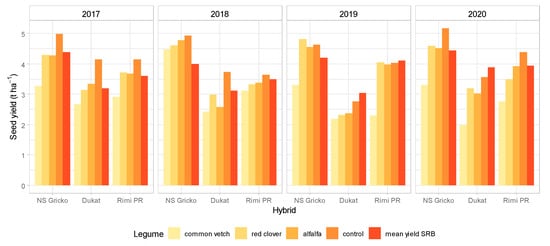
Figure 5. Sunflower seed yield in intercrops compared to average yield in multi-environment trials in Republic of Serbia agroecological conditions (average yield SRB-unpublished data from IFVCNS multi-environment trials).
9.1. Yield and Yield-Related Traits in Sunflower
9.2. Biomass and Biomass Related Traits in Legumes
9.3. Land Equivalent Ratio (LERmax)
10. Conclusions
References
- Debaeke, P.; Casadebaig, P.; Flenet, F.; Langlade, N. Sunflower crop and climate change: Vulnerability, adaptation, and mitigation potential from case-studies in Europe. OCL Oilseeds Fats Crop. Lipids 2017, 24, D102.
- IPCC. Climate Change 2014: Synthesis Report. In Core Writing Team; Contribution of Working Groups I, II and III to the Fifth Assessment Report of the Intergovernmental Panel on Climate Change; Pachauri, R.K., Meyer, L.A., Eds.; IPCC: Geneva, Switzerland, 2014.
- Stomph, T.; Dordas, C.; Baranger, A.; de Rijk, J.; Dong, B.; Evers, J.; Gu, C.; Li, L.; Simon, J.; Steen Jensen, E.; et al. Designing intercrops for high yield, yield stability and efficient use of resources: Are there principles? Adv. Agron. 2020, 160, 1–50.
- European Commission. Communication for the Commission to the European Parliament, the Council, the European Economic and Social Committee and the Committee of the Regions. EU Biodiversity Strategy for 2030. Bringing Nature Back into Our Lives. 2020. Available online: https://eur-lex.europa.eu/legal-content/EN/TXT/?uri=CELEX:52020DC0380 (accessed on 21 April 2021).
- Vandenncer, J.H. The Ecology of Intercropping; Cambridge University Press: Cambridge, UK, 1989; p. 231. Available online: https://www.cambridge.org/core/journals/experimental-agriculture/article/abs/ecology-of-intercropping-by-j-h-vandermeer-cambridge-cambridge-university-press-1989-pp-237-3000/D053A24CEC50A9141A22CA758E7A2ADA (accessed on 21 April 2021).
- Caviglia, O.P.; Sadras, V.O.; Andrade, F.H. Intensification of agriculture in the south-eastern Pampas: I. Capture and efficiency in the use of water and radiation in double-cropped wheat–soybean. Field Crops Res. 2004, 87, 117–129.
- Ren, W.; Hu, L.; Zhang, J.; Sun, C.; Tang, J.; Yuan, Y.; Chen, X. Can positive interactions between cultivated species help to sustain modern agriculture? Front. Ecol. Environ. 2014, 12, 507–514.
- Šeremešić, S.; Manojlović, M.; Ilin, Ž.; Vasić, M.; Varga-Gvozdanović, J.; Subašić, A.; Vojnov, B. Effect of intercropping on the morphological and nutritional properties of carrots and onions in organic agriculture. J. Process. Energy Agric. 2018, 22, 80–84. Available online: https://scindeks-clanci.ceon.rs/data/pdf/1821-4487/2018/1821-44871802080S.pdf (accessed on 6 January 2021).
- Martin-Guay, M.O.; Paquetteb, A.; Duprasa, J.; Rivesta, D. The new Green Revolution: Sustainable intensification of agriculture by intercropping. Sci. Total Environ. 2018, 615, 767–772.
- Maitra, S.; Hossain, A.; Brestic, M.; Skalicky, M.; Ondrisik, P.; Gitari, H.; Brahmachari, K.; Shankar, T.; Bhadra, P.; Palai, J.B.; et al. Intercropping—A low input agricultural strategy for food and environmental security. Agronomy 2021, 11, 343.
- Rad, S.V.; Valadabadi, S.A.R.; Pouryousef, M.; Saifzadeh, S.; Zakrin, H.R.; Mastinu, A. Quantitative and qualitative evaluation of Sorghum bicolor L. under intercropping with legumes and different weed control methods. Horticulturae 2020, 6, 78.
- Federer, W.T. Statistical design and analysis for intercropping experiments: Volume 1: Two crops; Springer Science & Business: Berlin/Heidelberg, Germany, 2012.
- Brooker, R.W.; Bennett, A.E.; Cong, W.F.; Daniell, T.J.; George, T.S.; Hallett, P.D.; Hawes, C.; Iannetta, P.P.M.; Jones, H.G.; Karley, J.K.; et al. Improving intercropping: A synthesis of research in agronomy, plant physiology and ecology. New Phytol. 2015, 206, 107–117.
- Hauggaard-Nielsen, H.; Gooding, M.; Ambus, P.; Corre-Hellou, G.; Crozat, Y.; Dahlmann, C.; Dibet, A.; von Fragstein, P.; Pristeri, A.; Monti, M.; et al. Pea–barley intercropping for efficient symbiotic N2-fixation, soil N acquisition and use of other nutrients in Europe an organic cropping systems. Field Crop. Res. 2009, 113, 64–71.
- Ugrenović, V.; Ugrinović, M. Organska proizvodnja i biodiverzitet. In Pokrovni Usevi—Ostvarenje Održivosti u Sistemima Ekološke Poljoprivrede; Ugrenović, V., Filipović, V., Eds.; Institut “Tamiš”: Pančevo, Srbija, 2014; pp. 1–15.
- Iverson, A.L.; Marín, L.E.; Ennis, K.K.; Gonthier, D.J.; Connor Barrie, B.T.; Remfert, J.L.; Cardinale, B.J.; Perfecto, I. Do polycultures promote win-wins or trade-offs in agricultural ecosystem services? Ameta-analysis. J. Appl. Ecol. 2014, 51, 1593–1602.
- Bousselin, X.; Cassagne, N.; Baux, A.; Valantin-Morison, M.; Herrera, J.M.; Lorin, M.; Hédan, M.; Fustec, J. Interactions between plants and plant-soil in functionally complex mixtures including grass pea, faba bean and niger, intercropped with oilseed rape. Agronomy 2021, 11, 1493.
- de la Fuente, E.; Suárez, S.; Lenardis, A.; Poggio, S. Intercropping sunflower and soybean in intensive farming systems: Evaluating yield advantage and effect on weed and insect assemblages. NJAS—Wagening. J. Life Sci. 2014, 70–71, 47–52.
- FAO—Food and Agriculture Organization of the United Nations. World Fertilizer Trends and Outlook to 2020. 2017. Available online: http://www.fao.org/3/i6895e/i6895e.pdf (accessed on 12 December 2020).
- Jensen, E.S.; Carlsson, G.; Hauggaard-Nielsen, H. Intercropping of grain legumes and cereals improves the use of soil N resources and reduces the requirement for synthetic fertilizer N: A global-scale analysis. Agron. Sustain. Dev. 2020, 40, 5.
- International Union of Soil Sciences (IUSS) Working Group WRB. World Reference Base for Soil Resources 2014, update 2015. In International Soil Classification System for Naming Soils and Creating Legends for Soil Maps; World Soil Resources Reports No. 106; FAO: Rome, Italy, 2015; Available online: http://www.fao.org/3/i3794en/I3794en.pdf (accessed on 12 December 2020).
- Granlund, M.; Zimmerman, D.C. Effect of drying conditions on oil contents of sunflower (Helianthus annuus L.) seed determined by wide-line Nuclear Magnetic Resonance (NMR). North Dak. Acad. Sci. Proc. 1975, 27, 128–132.
- Willey, R.W. Intercropping—Its importance and research needs. I. Competition and yield advantages. Field Crop. Abstr. 1979, 32, 1–10.
- SAS Institute. The SAS System for Windows; Release 9. 2; SAS Inst.: Cary, NC, USA, 2011.
- IBM Corp. Released. IBM SPSS Statistics for Windows; Version 24.0; IBM Corp: Armonk, NY, USA, 2016.
- Donatelli, M.; Srivastava, A.K.; Duveiller, G.; Niemeyer, S.; Fumagalli, D. Climate change impact and potential adaptation strategies under alternate realizations of climate scenarios for three major crops in Europe. Environ. Res. Lett. 2015, 10, e75005. Available online: https://iopscience.iop.org/article/10.1088/1748-9326/10/7/075005/pdf (accessed on 22 February 2021).
- Debaeke, P.; Casadebaig, P.; Langlade, N.B. New challenges for sunflower ideotyping in changing environments and more ecological cropping systems. OCL 2021, 28, 29.
- Mrđa, J. The Effect of Seed Quality on the Developmental Dynamics, Yield and Quality of Sunflower. Ph.D. Thesis, Faculty of Agriculture, University of Novi Sad, Novi Sad, Serbia, 2015. Available online: https://www.cris.uns.ac.rs/DownloadFileServlet/Disertacija144611228383810.pdf?controlNumber=(BISIS)96075&fileName=144611228383810.pdf&id=4497&licenseAccepted=true (accessed on 8 November 2020).
- Kholghi, M.; Bernousi, I.; Darvishzadeh, R.; Pirzad, A. Correlation and path-coefficient analysis of seed yield and yield related trait in Iranian confectionery sunflower populations. Afr. J. Biotechnol. 2011, 10, 13058–13063. Available online: https://www.ajol.info/index.php/ajb/article/view/96515/85837 (accessed on 8 November 2020).
- Radanović, A.; Miladinović, D.; Cvejić, S.; Jocković, M.; Jocić, S. Sunflower genetics from ancestors to modern hybrids—A review. Genes 2018, 9, 528.
- Škorić, D.; Mihaljčević, M.; Jocić, S.; Marinković, R.; Dozet, B.; Atlagić, J.; Hladni, N. The latest achievements in sunflower breeding. In Proceedings of the 37. Savetovanje Proizvodnja i Prerada Uljarica, Budva, Yugoslavia, 27–31 May 1996; Tehnološki Fakultet Novi Sad: Novi Sad, Srbija, 1996.
- Vratarić, M.; Sudarić, A. Oplemenjivanje i Genetika Suncokreta. U Suncokret (Helianthus annuus L.); Poljoprivredni Institut Osijek: Osjek, Hrvatska, 2004; pp. 69–162.
- Miller, J.F.; Hammond, J.J. Inheritance of reduced height in sunflower. Euphytica 1991, 53, 131–136.
- Schneiter, A.A. Production of semi dwarf and dwarf sunflower in the northern Great Plains of the United States. Field Crop. Res. 1992, 30, 391–401.
- Velasco, L.; Pérez-Vich, B.; Muñoz-Ruz, J.; Fernández-Martínez, J.M.; Friedt, W. Inheritance of reduced plant height in the sunflower line Dw89. Plant Breed. 2003, 122, 441–443.
- Beg, A.; Pourdad, S.S.; Pala, M.; Oweis, T. Effect of supplementary irrigation and variety on yield and some agronomic characters of sunflower growing under rainfed conditions in northern Syria. Helia 2007, 30, 87–98.
- Balalić, I. Multivariate Analysis of Interaction between Hybrids and Planting Dates for Oil Content, Yield and Yield Components in Sunflower. Ph.D. Thesis, Faculty of Agriculture, University of Novi Sad, Novi Sad, Serbia, 2009.
- Marinković, R.; Dozet, B.; Vasić, D. Sunflower Breeding; Monography, Školska Knjiga: Novi Sad, Serbia, 2003.
- Gontcharov, S.; Zaharova, M. Vegetation period and hybrid sunflower productivity in breeding for earliness. In Proceedings of the 17th International Sunflower Conference, Cordoba, Spain, 8–12 June 2008; pp. 531–533. Available online: https://www.isasunflower.org/fileadmin/documents/aaProceedings/17thISC_CordobaVol2/531sergey.pdf (accessed on 6 January 2021).
- Olowe, V.I.O.; Adebimpe, O.A. Intercropping sunflower with soya beans enhances total crop productivity. Biol. Agric. Hortic. 2009, 26, 365–377.
- Kandel, H.J.; Schneiter, A.A.; Johnson, B.L. Intercropping legumes in to sunflower at different growth stages. Crop Sci. 1997, 37, 1532–1537.
- Hladni, N.; Jocić, S.; Miklič, V.; Miladinović, D.; Zorić, M. Interrelationship between 1000 seed weight with other quantitative traits in confectionary sunflower. Ekin J. Crop Breed. Genet. 2016, 2, 51–56. Available online: https://dergipark.org.tr/en/download/article-file/211599 (accessed on 8 November 2020).
- Rosner, K.; Bodner, G.; Hage-Ahmed, K.; Steinkellner, S. Long-term soil tillage and cover cropping affected arbuscular mycorrhizal fungi, nutrient concentrations, and yield in sunflower. Agron. J. 2018, 110, 2664–2672.
- Dowling, A.; Sadras, V.O.; Roberts, P.; Doolette, A.; Zhou, Y.; Denton, M.D. Legume-oilseed intercropping in mechanised broad acre agriculture—A review. Field Crop. Res. 2021, 260, 107980.




